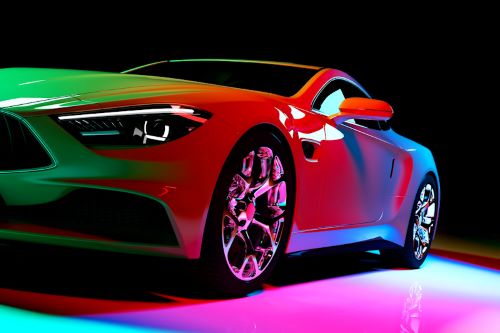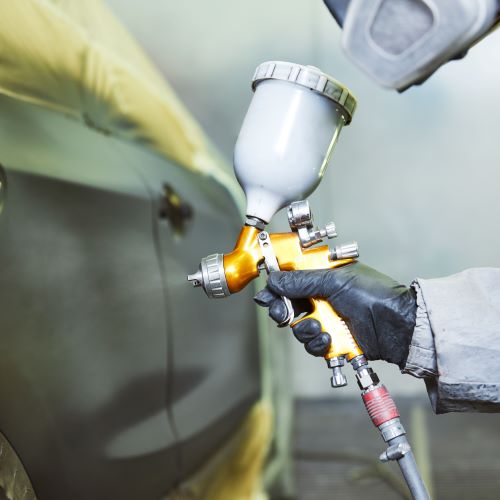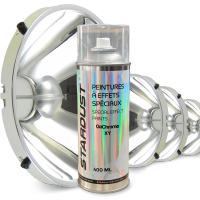All Products are in stock
and shipped from France.
Delivery within 48 hours.
and shipped from France.
Delivery within 48 hours.
Our categories
 How to properly dry the different layers of a car coating ?
How to properly dry the different layers of a car coating ?
Among the different stages in the implementation of a paint, there are several drying periods, with the intervals that separate each phase of a paint system (primer / base / finish) and a final stage that allows the complete "through-drying" of an automotive paint or finish before it is delivered to the customer and put into circulation.
The drying of a paint is the transition from the liquid state of the paint to the dry state. This transition requires the loss by evaporation of part of this liquid paint, represented by the solvents. In the art of painting vehicles, solvent- or water-based coatings are used. In the case of a single-component product, we speak of complete drying of the paint or clearcoat, when all the water or solvents have left the paint. The drying of a two-component paint also includes the evaporation of solvents, but in addition, there is a chemical hardening by reaction between a hardener (component 2) and component 1 (resin, clearcoat or lacquer).
When implementing a paint, it is essential to respect the drying time periods between the superposition of layers, and also the final and complete drying time of the paint.
On the other hand, an important distinction is made between air drying and "forced drying" : in the first case, it is a question of letting the paint dry by simple evaporation at moderate and natural ambient temperature , without external intervention.
In the second case, we speak of forced drying or curing : it is essentially a technique used for the final and complete drying, in order to deliver the vehicle more quickly to its customer and especially to declutter the paint booth. Baking is rarely mandatory, whatever the paint or varnish, to obtain a good result. This is an optional drying process, but it is true that baking can increase the chances of maintaining a beautiful shine.
Drying and baking paints
When applying paint, regardless of the method of application, it is rare that the process simply requires a single coat. Depending on the technical data sheet and the instructions, two layers are therefore applied, or more depending on the type of product.
The succession of the different layers of a product must be done respecting a certain time interval, which depends itself from the more or less warm ambient temperature. For example, for a bodywork clearcoat, you have to wait 7 to 10 minutes between the two coats. Failure to wait long enough will not allow the solvent from the first coat to evaporate sufficiently, and furthermore, the second coat may run. In the case of a solvent-based two-coat paint, there is no need to wait so long, because this very thin paint has the advantage of drying very quickly. On the contrary, when using two-layer paints of the Hydro type, it is necessary to lengthen this drying interval between the layers, because water is a solvent of low volatility, which evaporates rather slowly. It is also customary to use a Hydro paint dryer which projects air onto the surface of the paint, in order to accelerate evaporation.
When painting a paint, primer, lacquer or clearcoat, the product can be allowed to dry at room temperature. The temperature should then be between 15 and 25 degrees Celsius. Below this temperature, the evaporation of the solvents will not be done properly and the drying will be slowed down, which can cause runs. On the contrary, if the temperature is too high, the drying will be too fast. Various defects can then occur, with in particular a loss of gloss of the clearcoats, too rapid drying of the surface layer of the paint film, with imprisonment of the solvents in the deep layer and sometimes also the formation of wrinkles on the lacquers and the clearcoat.
Firings significantly accelerate drying and hardening through the core. Baking is only used for finishing paints, such as lacquers and varnishes. Primers and coat paints dry too quickly to require baking, except exceptionally in very cold weather. Forced drying is done with infrared or ultraviolet lamps. It can also be done in the booth thanks to the hot air produced by the paint booth. Booth air must be renewed during curing, otherwise the solvents will affect the gloss level of the surface layer.
 "Flash off" time and desolvation
"Flash off" time and desolvation
The recovery must be done during a specific and limited period. Too early does not allow the solvent of the lower layer to have evaporated, and too late the lower layer has already dried up and it is no longer possible to cling to its surface. The minimum recoat period is called "Flash Off" by body painters.
In another case, when planning to bake a finishing paint, it is absolutely not possible to put the fresh paint directly in the oven or under the heat of the baking lamps. It is imperative to respect a period of time called "desolvation". This technical term often appears in data sheets. It is important to know it, to understand it and to respect it : if you bake a freshly painted piece directly in a hot atmosphere, for example at 60 or 70°, then the surface will dry out prematurely, while the core of the paint remains wet, with the result that the solvents are trapped, which can later be released in the form of micro bubbles.
Characteristics of cooking with infrared lamps and ultraviolet lamps
Heating a paint booth to 60 to 70° is effective when you want to dry a complete vehicle. For small parts or partial repair, this technique is much less economical. In such cases, painting professionals prefer to use portable lamps to heat and dry the touch-up paint areas. The most used drying lamps are infrared lamps. These lamps emit heating red light with short or long waves. Quick and efficient, the drying of the new short-wave IR lamps represents a technique and a form of ecological energy for painting work. With drying times reduced from 45 to 10 minutes on average.
UV lamps are still little used in the world of body painting. However, they are an ideal drying mode, because they are faster than other conventional lamps. UV can dry coatings in minutes. In addition, they do not overheat the surface and this is an advantage when working on fragile surfaces such as plastics.
The different drying times depending on the product
If you've ever read a body paint spec sheet, then you've seen the following terms :
Dry to the touch / apparent dry : this is when you can touch the paint without making a mark. The surface is dry in appearance / on the surface.
Dust-free : this is a higher degree of drying, where the painted part can be taken out of the paint booth to be stored outside without fear that dust may stick to it . Drying can continue quietly.
Dry Through : This is when you can press a finger to the surface of the polish without creating a mark. This is also the time when the vehicle can be put into service and delivered to customers. This does not mean that the paint has acquired its maximum properties of hardness, which, in truth, will occur several days after drying through. This goes for any paint, for example car paint, or even parking floor paint for example.
Quick polishes
In order to optimize the work of bodywork painters, by reducing the energy consumption and the occupation time dedicated to drying in the paint booths, certain finishing clearcoats endowed with particular properties have acquired a certain success : these are fast varnishes. Usually, finishing paints are ultra-resistant and shiny products that require a long drying time, which ranges from 12 to 24 hours. Electric curing processes, such as the oven or curing lamp, are effective in speeding up drying times, but they are energy-intensive.
The new rapid clearcoats, thanks to their innovative chemistry, make it possible to shorten the commissioning time, from 24 hours down to just 60 or 90 minutes. This means that one hour after the application of the paint, the customer can potentially recover his vehicle and drive ! You can find this type of clearcoat in the Stardust catalog : it is the "WET SPEED" clearcoat which is one of the best clearcoats to really dry in 60 minutes through !
General techniques for applying paints and lacquers
Coating and varnishing a painting
Specific techniques applied to painting














































































